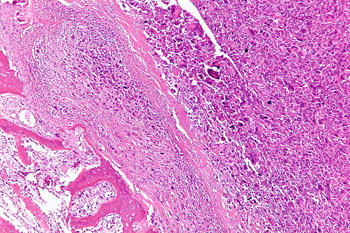MicroRNA-Nanoparticle Complexes Prevent Growth of Osteosarcoma Cells
By LabMedica International staff writers
Posted on 08 Mar 2016
Cancer researchers developed a nanoparticle delivery system to transport dormancy-inducing microRNAs into osteosarcoma cells.Posted on 08 Mar 2016
Osteosarcoma is a cancer that develops in the bones of children and adolescents. It is one of the most aggressive cancers, with only a 15%, five-year survival rate when diagnosed at an advanced metastatic stage. There are approximately 800 new cases diagnosed each year in the USA, and there are no viable treatments.

Image: Intermediate-magnification micrograph of an osteosarcoma (center and right of image) adjacent to nonmalignant bone (left-bottom of image) (Photo courtesy of Wikimedia Commons).
Investigators at Tel Aviv University (Israel) and their collaborators at Freie Universität Berlin (Germany) established paired active and dormant osteosarcoma tumors in mice and then compared their microRNA activities. MicroRNAs are a class of about 20 nucleotides-long RNA fragments that block gene expression by attaching to molecules of messenger RNA in a fashion that prevents them from transmitting the protein synthesizing instructions they had received from the DNA. With their capacity to fine-tune protein expression via sequence-specific interactions, microRNAs help regulate cell maintenance and differentiation.
The investigators identified three novel microRNA regulators of osteosarcoma dormancy: miR-34a, miR-93, and miR-200c. Loss of these microRNAs occurred during the switch from non-growing dormant tumors into fast-growing tumors with angiogenic phenotypes.
To maintain the dormant state or to return active tumors to this condition, the investigators planned to insert the three microRNAs into the cancer cells. However, as successful delivery of miRNAs is difficult to achieve, the investigators synthesized an aminated polyglycerol dendritic nanocarrier, dPG-NH2, and designed dPG-NH2-microRNA polyplexes to target the cancer cells.
They reported in the January 27, 2016, online edition of the journal ACS Nano that Saos-2 and MG-63 osteosarcoma cells, which generate fast-growing tumors, accepted the nanoparticles. Reconstitution of the dPG-NH2-microRNA polyplexes inside the cells caused reduction of the levels of their target genes, MET proto-oncogene, hypoxia-inducible factor 1-alpha, and moesin, all of which are critical to cancer angiogenesis and cancer cells’ migration. The microRNAs weakened the angiogenic capabilities of fast-growing osteosarcomas in vitro and in vivo. Furthermore, treatment with each of the microRNAs using dPG-NH2 significantly prolonged the dormancy period of fast-growing osteosarcomas in vivo.
"We saw that the osteosarcoma cells treated with the selected microRNAs were unable to recruit blood vessels to feed their growth," said senior author Dr. Ronit Satchi-Fainaro, professor of physiology and pharmacology at Tel Aviv University. "In order to keep these microRNAs stable in the blood, we needed to encapsulate them in a nanoparticle that circulates in healthy blood vessels, but that disembark and deliver the drug therapy at the leaky blood vessels that exist at tumor sites. We designed a nanomedicine that would have a special activation method at the tumor site in the target cell. The mice treated with the nanomedicine lived for six months, which is the equivalent of 25-odd human years. This makes us very optimistic. If we cannot teach tumor cells to be normal, we can teach them to be dormant."
"This has huge potential," said Dr. Satchi-Fainaro, "because the insertion of microRNA affects many, many genes—making it that much more difficult for cancer to avoid them and compensate for their loss with an alternative pathway. I hope our findings will apply to other tumor types as a universal approach to treating cancer."
Related Links:
Tel Aviv University
Freie Universität Berlin














